
Landscapes may be a source of inspiration, enjoyment, and contemplation. At the first glance, what we see appears to be obvious: fields, settlements, mountains … An interested observer may think about processes and economic structures that have transformed the earth surface. Difficulties arise when landscapes are abandoned, erased, and deprived of actors and social context. What can be derived from them? What or whom do they represent? Can the current conceptualisations help to capture their meanings?
The Russian/Soviet settlements on Svalbard, Norway
The Russian/Soviet settlements of Barentsburg, Pyramiden, and Grumant, located in Svalbard (Norway) offer an interesting case to study abandoned, semi abandoned, and ‘haunted’ landscapes. Established as coal-mining settlements, they have followed different paths. While coal mining in Barentsburg has continued since the 1920s (with an interruption during World War II), Grumant was abandoned in 1961, and Pyramiden in 1998. These three places now have unique symbolic roles. While Grumant is a typical ruined landscape, Pyramiden and Barentsburg have recently had their image redefined (Gerlach and Kinossian, 2016). Pyramiden now represents the Soviet Arctic, and Barentsburg the modern Russian Arctic. Both places respond to the curiosity of Russian and foreign tourists who seem to be puzzled by the presence of Soviet/Russian settlements on the Norwegian territory.
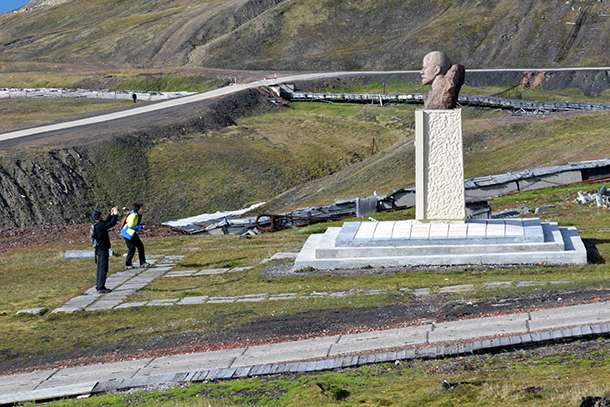
Both Pyramiden and Barentsburg have a distinct ‘Soviet’ appearance. The Soviet past and elements of monumental propaganda amid abandoned buildings have emerged as a ‘theme’ in tourism promotion strategies. Abandoned, transformed, and partly erased landscapes of the Russian/Soviet settlements on Svalbard provokes further questions concerning the use of the Soviet past, meanings hidden within landscapes, and the connections between the observer and the landscape.
Haunted Landscapes
When a landscape is abandoned or cleared, the function of representation is obstructed, and the landscape cannot be seen as a ‘messenger’ communicating meaning to the observer (Kinossian, 2018). The observer’s own imagination plays a more prominent role in putting the elements of the puzzle together and interpreting their meaning.
What one may find particularly striking about abandoned landscapes is the unexpected and unwanted presence of persons who are not physically there, albeit they may have the right to be there. Such ‘presence’ is described as ‘haunting’. Through haunting we become aware of “a repressed or unresolved social violence”, the victims of which have not been recognised or commemorated or have been forgotten (Gordon, 2008, xvi). People who have been forcibly removed, or murdered are not present or visible. They have the right to claim their place, the right to be recognised, comforted, and remembered; yet they appear as ghosts.
Engagement with the haunted landscape of an abandoned town generates fascination and amusement that visitors (consciously or unconsciously) seek to experience. Haunted landscapes cannot communicate a coherent message. Instead they send disconnected, obscured, and interrupted signals that the observer has difficulty reading. Consequently, imagination kicks in, thereby opening the landscape for interpretation. The idea of the ghost as a fictitious interlocutor links the observer and the haunted landscape. The ghost haunts visitors, disturbs them, begs for attention, engages in conversation, and provokes questions.
Abandoned Pyramiden and reviving Barentsburg
Tourists can reach Pyramiden by boat, snowmobile, or helicopter. Upon their arrival, boat operators pass tourists over to the Russian guides from the Arctic Travel Company Grumant – a subsidiary of Arktikugol’ – who take them on a guided tour. A two-hour tour typically includes a walk through the settlement and visits to several buildings, including the hotel Tyulpan (Tulip). Many other buildings, including the hospital, school, workshops, and workers’ dormitories, are not accessible during a short tour.
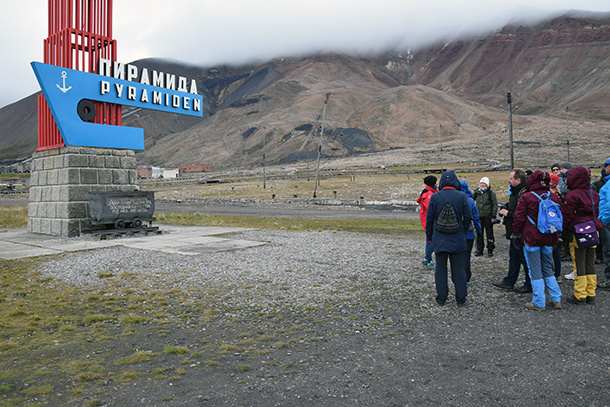
Although Pyramiden was abandoned more than 20 years ago, buildings and things inside them still bear the uncanny feeling of human presence. People who visit abandoned places contemplate what the lives of the former residents might have been like. The ghost reminds visitors about past events and persons that have been forgotten, ignored, or erased from memory. This stimulates self-reflection and thinking about identity and belonging, causing one to ask questions such as, “If I was here and then, what would I do?”
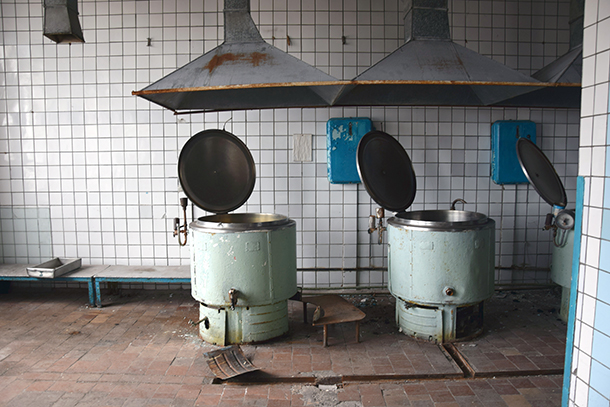
In sharp contrast to the abandoned settlement of Pyramiden, Barentsburg seems to be full of life. The coal mine still operates. The whole place is a company town run by Arktikugol’ – the Russian state enterprise responsible for mining on Svalbard (https://www.arcticugol.ru). Here and there, workers repair the façades of buildings and elevated over ground pipes, miners walk to and from their shifts, women go shopping, delivery vehicles bring goods to shops and hotels. Tourists – in groups and individually – walk around, take pictures, and wander into the museum, tourist office, souvenir shops, bars, and restaurants.

Taken over by the pursuit of modernity and economic viability, Barentsburg is losing its unique Soviet aura. Refurbished façades resemble those anywhere else in provincial Russia. Some elements of Communist monumental propaganda have recently disappeared – either intentionally demolished or covered up by new façades.
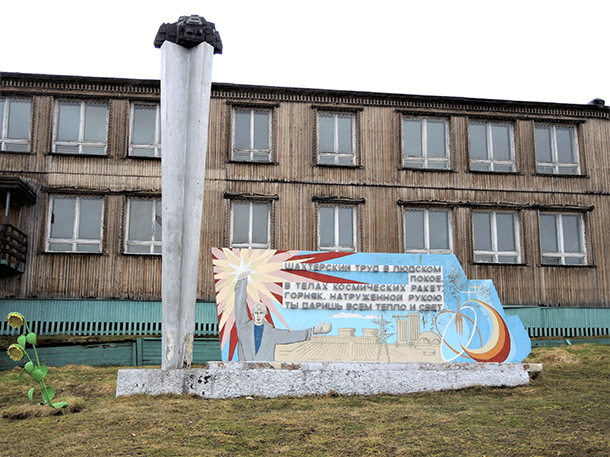
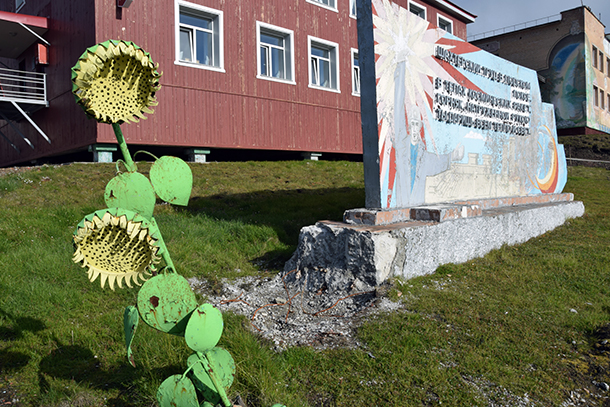
Despite these changes, in both Barentsburg and Pyramiden, Soviet symbols and narratives are still present. A concrete stela with the inscription “Our Goal is Communism!” is still located in the centre of Barentsburg. Busts of Lenin remain in place at both settlements. Souvenir shops sell various merchandise bearing Soviet symbols, including “Back to USSR” T-shirts; “Welcome to our Arctic time machine” reads the message printed on the front.

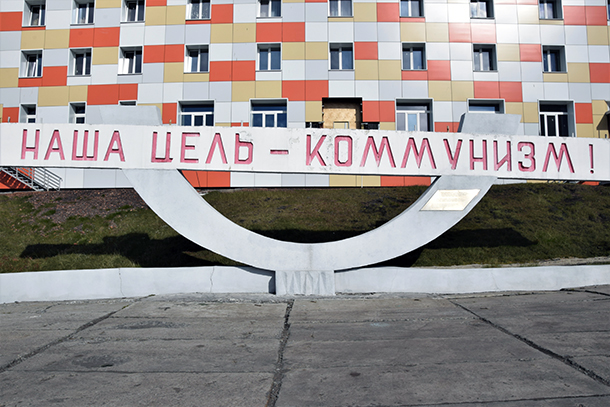
The landscape of the Soviet/Russian settlements sends a confused message whereby narratives of the Arctic, the history of exploration, and the Communist workers’ paradise appear in a palimpsest-like form. The Communist ideology praised working-class people, celebrating their heroism and dedication. Monumental propaganda has created a romanticised image of the Soviet worker: triumphant, young, and strong, (s)he celebrates the achievements of the Communist system. In contrast, the modern managers of the mine do not have a ‘vision’ of the working class under the current conditions. The current workers become increasingly marginalised and de-contextualised as the mining activities lose economic relevance.
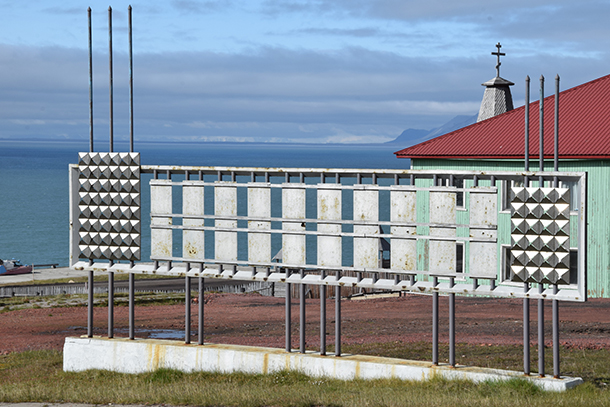
The local workers and visitors represent the two parallel worlds that seemingly do not overlap. Those who came to Barentsburg to earn money – versus to spend it – belong to different professional and social strata and often to different countries. Prices in tourist bars and restaurants are well beyond the means of an average mine worker. One night out in a restaurant catering for tourists can cost as much as a local worker’s monthly salary. Therefore, the places created to generate currency-flow from tourism, and those intended for the workers, largely stick to their own clientele.
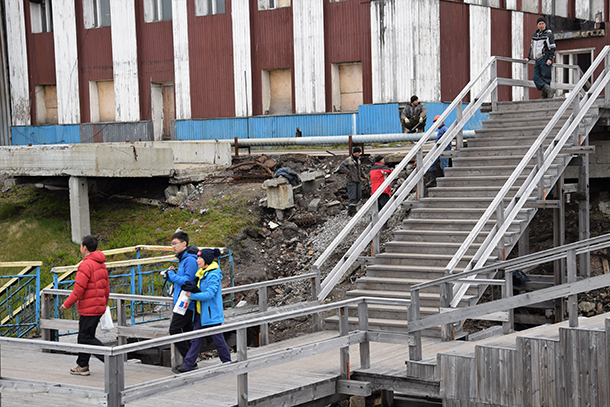
Svalbard’s haunted landscapes
Observing landscapes of Pyramiden and Barentsburg leaves an impression of void, disconnection, and the presence of the ghost. At the societal level, this impression is created by the alienated position of the Soviet/Russian settlements. Political and cultural differences mean that they do not ‘belong’ to Norwegian Svalbard. Designed and built according to other principles, they were once populated by workers sent there by the Soviet Government to ‘build communism’ – both locally and (as ultimately envisioned) on the planetary scale. After the collapse of communism, the loss of the overall political and economic context, and the physical abandonment of some settlements, created a specific feeling of a haunted place. As mining is losing (or has already lost) its economic viability, both Norway and Russia consider it strategically important to maintain their presence on Svalbard. The Russian Government, acting through Arktikugol’, is implementing a restructuring programme to introduce new economic activities such as tourism to replace coal mining as the ‘anchor’ activity there.
Commercialisation is transforming urban Svalbard: there are increasing numbers of hotels and dining places in Longyearbyen and Barentsburg. The commercialisation of the past, and especially of the Communist past, can be seen as a disturbing and uncritical use of a narrative of totalitarianism for marketing purposes. Soviet-styled merchandise is intended to contribute to the new economy of the Russian settlements.
At the human level, that impression is created by the position of the mine worker then and now. The Soviet workers of earlier times have disappeared along with the USSR. Their memories are gradually being erased, giving way to written accounts and official records. The narratives of the Soviet workers’ paradise in the Arctic – although devoid of much substance – have become a central element of the officialised cultural landscape created by current policy makers and tour operators as authorised narrators. Remaining miners and paying tourists belong to different universes, being strangers – if not ghosts – to each other.
Being surrounded by an environment once full of life and meaning places observers in an interesting position. On the one hand, observers are ‘intruders’ in the material settings to which they do not belong, which they have not created, and with which they are only partly familiar (if at all). Despite the abandonment and void, the observers are constantly reminded of the presence of a ghost, by various buildings, ruins, left-over objects, images, and narratives. On the other hand, visitors/intruders may like to occupy the void by associating with the ghost, feeling empathy, and imagining themselves as those who previously lived and worked in that environment. The presence of the ghost is felt, giving the intruder a chance to contemplate the destiny of a place and the fate of the bygone residents who once occupied it. This engagement or a dialog with the ghost as a fictitious character may be a way to answer the questions invoked by the haunted landscapes of Svalbard.
Dr Nadir Kinossian is a senior researcher at the Department of Regional Geography of Europe at the IfL.
A full version of this article has been published under Creative Commons Attribution 4.0 International License:
Kinossian, Nadir (2020): Svalbard’s Haunted Landscapes. Nordlit, 45 (February), pp. 86–103. https://septentrio.uit.no/index.php/nordlit/article/view/5028
References
Gerlach, Julia and Kinossian, Nadir (2016): Cultural landscape of the Arctic: ‘Recycling’ of Soviet imagery in the Russian settlements on Svalbard (Norway). Polar Geography 39 (1), pp. 1–19. https://doi.org/10.1080/1088937X.2016.1151959
Gordon, Avery (2008): Ghostly Matters. Haunting and the Sociological Imagination (New Edition). Minneapolis: University of Minnesota Press.
Kinossian, Nadir (2018): Cities as haunted landscapes. City and Society 30(1). https://doi.org/10.1111/ciso.12151
Kinossian, Nadir (2020): Svalbard’s Haunted Landscapes. Nordlit, 45, pp. 86–103. https://septentrio.uit.no/index.php/nordlit/article/view/5028
